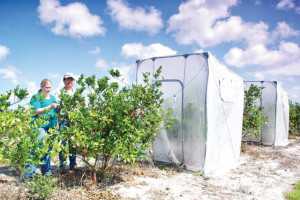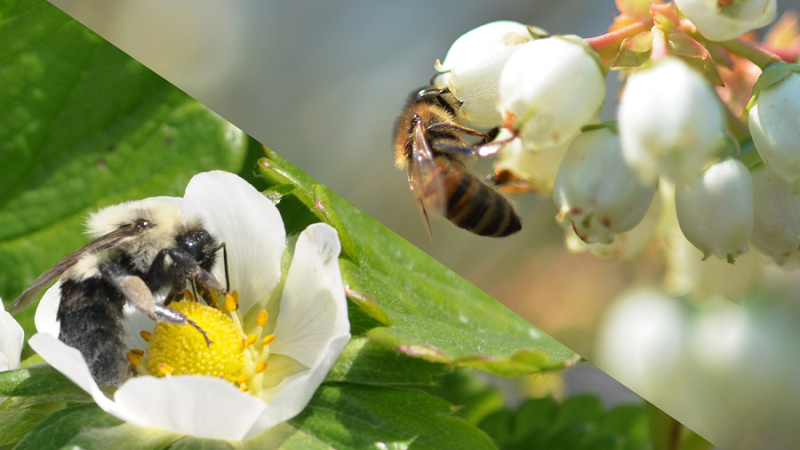Researchers Look To The Sun For Help In Citrus Greening Fight

Dr. Yong-Ping Duan and colleague Melissa Doud inspect tented citrus trees undergoing heat treatment.
Photo courtesy of USDA
Scientists have thrown a lot of research toward HLB in hopes of finding ways to mitigate the threat to Florida’s citrus industry. Many agree the solution might not come as a silver bullet fix, but from a number of approaches targeting the psyllid and the bacteria that spreads the disease.
Researchers at USDA’s Horticultural Lab in Ft. Pierce believe one of those fixes could come by turning up the heat on HLB — literally. Thermotherapy has been used to treat other plant diseases, including citrus viral diseases. Dr. Yong-Ping Duan, a plant pathologist at the lab, decided to test the approach on the HLB bacteria. He has worked closely with USDA-ARS colleagues Michele Hoffman, Melissa Doud, David Hall, and Ed Stover in the research project.
“We came up with the idea to impose heat stress to infected trees and first treated potted HLB-affected citrus with various temperatures above 98.6°F for two to 10 days under controlled conditions,” says Duan. “Through the research, we were able to narrow down temperatures and durations needed to suppress or eliminate the HLB bacteria in the potted tree.”
From initial experiments, the scientists found that young infected potted plants exposed to constant heat of 104°F for 48 hours in a controlled growth chamber completely killed the HLB bacterium Candidatus Liberibacter asiaticus (Las). “These cured potted trees have remained disease free for three years in a psyllid-free greenhouse,” says Duan.
Taking It To The Groves
With the excellent results in the lab, Duan turned to test the technique in the field. To generate extra heat in field experiments, Duan utilized tents to place around infected trees.
“Our outside tent experiments began in February 2011 at our Picos Farm,” says Duan. “We initially started with very large 9-foot tall tents, but soon after changed to 6-foot tall tents. Our first trial of commercial heat treatment experiments began in March 2011.”
While lab results showed heat would kill HLB in potted trees, the field trials indicate thermotherapy will suppress the bacteria but not eliminate it. “Solar energy can heat the air inside the tent above 104°F for a few hours a day,” says Duan. “Our results have shown that the heat treatment can kill some of the HLB bacteria in the canopy but is unable to penetrate the soil to kill the bacteria in the roots. Thus, after heat treatment, there is a reduction in Las in the tree but not a complete elimination.
“This reduction in bacteria is greatest within the first six months after heat treatment. Any flush that develops after heat treatment within that time is asymptomatic for HLB. Symptoms are still present in the old symptomatic leaves that existed before the treatment. As time goes on, the amount of bacteria increases. The rate of increase varies from tree to tree. Much of our data still shows Las present in the trees two years after heat treatment but the bacterial titer (concentration) was still less than the amount of bacteria present before treatment. Additionally as the leaves age, post treatment leaves will eventually show typical HLB symptoms.”
While the heat treatment doesn’t eliminate HLB, one of the most notable effects can be seen in the overall growth of treated trees. “Those trees treated will soon after produce a large flush throughout the whole tree, while non-treated trees continue to decline,” says Duan. “Results have shown that most heat-treated trees continue to grow well for at least two years.”
Growers Giving It A Try
Duan utilized commercially available tents for his research, but he says some growers are building their own. “Many of the homemade tents have been constructed out of PVC pipe and visqueen,” he says. “Some people simply lie a stretched out roll of visqueen over the trees and then tuck the bottom of the plastic into the ground using soil to weigh the material down.”
Currently, Duan is cooperating with three growers for field trial research. “In general, growers are optimistic about thermotherapy and are pleased with the results,” he says. “They have stated that they notice increased growth and fruit production from treated trees that were beginning to decline before treatment. Growers are now interested in determining how long the positive effects will last and developing ways to more conveniently heat treat trees.”
HLB Heating Pointers
Research shows several important considerations in thermotherapy:
- Treatments are recommended during hottest months of the year or when daytime temperatures are in the mid-80s or higher for most of the day. If it is quite sunny and the temperatures are high enough, the treatment window can start as early as mid-March and run into early October. Heat treatments in the winter are not effective.
- Treatment times are subject to variation, but the shortest duration is 72 hours. This would be at least three days where the outside temperature gets close to or above 90°F and afternoon storms don’t start before 2 p.m. (June-August). These conditions will allow the inside of the tent to be above 104°F for at least two hours to potentially eight hours each day. Type of tent, weather (rain and temperature), and size of tree all affect treatment times.
- Monitor temps inside tent because it is possible to burn or kill the scion. Multiple hours above 125°F for more than two days can burn off the canopy of a 5-foot tree. Vent the tent if more than the top foot of the tree becomes brown or temperatures exceed 125°F.










